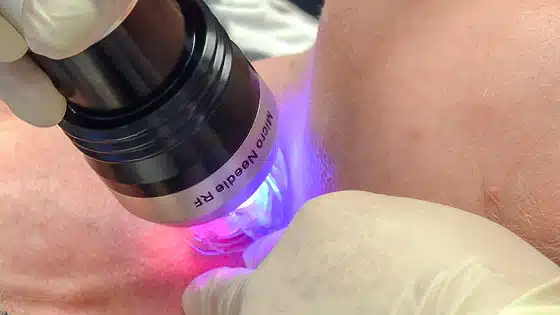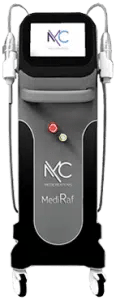Stretch mark reduction using the CO2 Fractional Laser combined with Radiofrequency (RF) Microneedling produces superior results leading to higher patient satisfaction.

Common causes of stretch marks include puberty, pregnancy, and rapid weight gain or loss and they most often affect the buttocks, thighs, abdomen, back, and breasts. Initially appearing as red, purple, or pink streaks, they gradually fade to a lighter color over time, but may never completely disappear.



Laser stretch mark reduction can produce noticeable improvements in the appearance of stretch marks, although individual results may vary based on factors such as the severity of the stretch marks and the patient’s skin type.
With laser treatments, patients can expect a reduction in the length, width, and depth of stretch marks, resulting in smoother and less pronounced skin texture.
Furthermore, laser treatment can help fade the red or purple discoloration often associated with new stretch marks, as well as stimulate collagen production to improve skin elasticity and firmness. Over time, stretch marks may become less visible and blend more seamlessly with surrounding skin, leading to a more uniform and aesthetically pleasing appearance.
While complete elimination of stretch marks may not always be achievable, laser treatments can significantly diminish their appearance, restoring confidence and enhancing overall skin quality.
Yes, laser stretch mark reduction can be performed on dark skin tones, but it requires careful consideration of the type of laser used and appropriate settings to minimize the risk of complications such as hyperpigmentation or hypopigmentation.
Certain types of lasers, such as fractional lasers and non-ablative lasers, are safer for use on darker skin tones because they target the deeper layers of the skin without causing damage to the surface. These lasers can help stimulate collagen production and improve the appearance of stretch marks without causing significant changes in skin pigmentation.
Laser stretch mark reduction can be performed on various areas of the body where stretch marks commonly occur. These areas include the abdomen, hips, thighs, buttocks, breasts, arms, back, and calves. Stretch marks can develop on these regions due to factors such as pregnancy, weight fluctuations, growth spurts, or hormonal changes.
By targeting the affected areas with lasers, patients can experience significant improvement in the appearance of their stretch marks. Whether located on the abdomen after pregnancy, the thighs following weight gain or loss, or the arms due to muscle growth, laser stretch mark reduction offers a comprehensive solution for achieving smoother, more even-toned skin.
Yes, generally speaking, new stretch marks are more responsive to laser treatments compared to older ones.
New stretch marks, often characterized by their red or purple coloration, indicate that they are in the early stages of formation and are typically more vascular and contain more collagen compared to older, white or silver stretch marks. The increased vascularity and collagen content make new stretch marks more responsive to laser treatments, as the laser energy can target and stimulate these structures more effectively. Laser treatment can help reduce the redness and inflammation associated with new stretch marks, as well as stimulate collagen production to promote healing and skin regeneration.
On the other hand, older stretch marks have undergone more structural changes in the skin, including a decrease in collagen and elastin production. While laser treatments can still be effective for treating older stretch marks, they may require more sessions and a combination of different laser modalities to achieve optimal results.